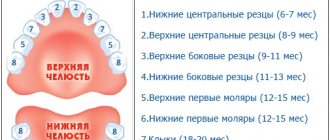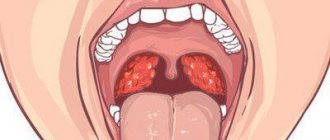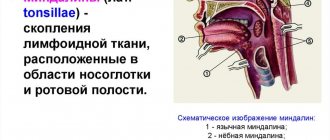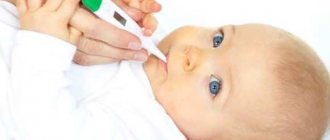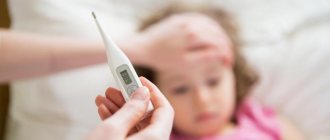The baby's throat is red, what should I do?
A red throat in a baby is a clear symptom of a progressive disease.
This illness causes serious inconvenience and discomfort for the child, the cause of which parents may not immediately identify.
Proper treatment of a baby’s throat will allow you to quickly remove the resulting swelling and get rid of the underlying disease, the symptoms of which can be snot, cough and runny nose.
Causes of red throat in children
In children under one year of age, the root cause of the appearance of a red throat may be inflammatory processes associated with viral or bacterial infection. When the body is affected by an infection, the tissues are saturated with blood, painful swelling is formed, the appearance of which is often accompanied by a sharp increase in the child’s temperature.
There are important differences between viral and bacterial infections:
- viruses penetrate the human body more easily, so they often cause illness in children under one year of age
- with a viral infection, the incubation period does not exceed 7 days; with a bacterial infection, it can reach from two to three weeks to one month
- with a bacterial infection, symptoms are difficult to detect; with a viral infection, the child’s temperature rises, a dry cough occurs, a runny nose and snot appear, and the throat turns red
- The symptoms of a viral infection are similar to acute respiratory infections, while a bacterial infection is more dangerous
- Bacteria can also infect a healthy body, while viruses are active only when the child’s immune system is weakened.
- antibiotics are most effective exclusively in the treatment of bacterial diseases; viral infections are not susceptible to their action
- viruses often cause redness of the skin; with bacterial infection, the skin usually becomes pale and painful
As a result of viral infections, a child may develop the following diseases: pneumonia, otitis media, bronchitis, sinusitis. These ailments usually have to be treated after the child has come into contact with sick children.
Against the background of reduced immunity after acute respiratory viral infection in infants under one year old, a bacterial infection can also join the virus. In this case, there is a high risk of developing tonsillitis, pharyngitis or complex forms of infectious diseases, such as scarlet fever.
Bacteria can enter a child’s body with unwashed food, personal items (handkerchiefs, towels), and in crowded places (swimming pool, gym, playroom).
In babies under one year old, the tonsils are the first to suffer from viral infections. Painful sensations spread to the mucous membrane of the throat, causing discomfort in the baby, which, due to his age, he cannot notify.
Treatment of a red throat in a baby
The first signs of the disease that parents can independently identify in a child under one year old are:
- changes in the structure of the throat (the appearance of ulcers, swelling, inflamed areas)
- baby has pain when swallowing, crying, breathing
- tongue swelling
- elevated temperature due to inflammation of the lymph nodes
- vomit
- lack of appetite
- coughing
- snot and runny nose that do not go away over a long period of time
It is necessary to treat a sore throat in a child a few months old under the supervision of a competent specialist. Banal cough, snot, runny nose, red throat can indicate either normal hypothermia or be symptoms of complex bacterial infections.
If the same cough or runny nose is not difficult to identify, then treating a throat in infants is not an easy task. In medicine, a number of methods and broad-spectrum drugs are used for these purposes.
Rinsing (irrigation)
Throat diseases in children can be effectively treated using the gargling method. During the process, plaque, mucus, pathogens and their environment are removed from the tonsils, recovery occurs quickly, and the temperature decreases. But for children a few months old, rinsing is unrealistic, so it is replaced by irrigation.
You can treat a sore throat in a baby using irrigation using the following formulations:
- warm saline solution: a teaspoon of salt per 200 ml of water, the optimal temperature of the composition is 35C
- infusion of medicinal herbs: plants with antiseptic and anti-inflammatory effects are suitable (sage, chamomile, eucalyptus)
- honey solution
- chlorophyllipt (non-alcoholic form - oil suspension)
- aloe juice (treatment is especially indicated for sore throat)
Irrigation is done after eating; it is better to use a spray bottle with a long and thin spout.
Inhalations
During inhalation, medications quickly reach the source of infection (throat mucosa) and relieve inflammation. A nebulizer is used for the procedure. As medications for children whose age is no more than 2-3 months, you can use saline solution, soda buffer, ambrobene, in difficult cases - Ventalin (diluted with saline solution).
Using inhalations, you can effectively treat snot, runny nose, and cough at home. After the procedure, you cannot go outside with your child or feed him for at least an hour. Doctors have differing opinions regarding whether inhalations can be performed if the patient has a fever. Most pediatricians recommend lowering it first and then inhaling it.
Medications
It is strongly recommended not to treat a sore throat with self-prescribed medications for an infant under 12 months of age. For these purposes the following can be used:
- tantum verde (treatment of sore throat, pharyngitis, tonsillitis)
- Theraflu Lar (for purulent formations on the tonsils, treatment of viral infections);
- efizol (relieves inflammation, temperature decreases faster).
After examining the baby, the doctor may additionally prescribe antibiotics (sumamed, amoxiclav, ciprolet, bioparox).
Komarovsky about the problem of red throat
Komarovsky confirms that in 90% of cases associated with intense sore throat in babies under 12 months of age and a little older, ARVI is diagnosed.
With this disease, along with a sore throat, a runny nose or nasal congestion occurs. If your child's nose is dry and his throat is red, these may be signs of sore throat or diphtheria.
Parents should also be alert to the baby’s high body temperature in such a situation.
Discomfort in the throat may also appear due to a critically low level of humidity in the room. The doctor strongly recommends using humidifiers and maintaining optimal temperature conditions in the nursery.
Source: https://chibi-co.ru/article/u-grudnichka-pokrasnelo-gorlo-chto-delat
Treatment
To determine how to treat a baby’s throat, you need to show the child to the doctor. Obviously, rinsing and irrigation with conventional preparations are excluded. Sometimes, of course, doctors prescribe medications based on their own experience of using them in children under one year old, but usually medications are intended for children from three years of age. Therefore, pediatricians offer other solutions:
- A suitable preparation can be lubricated from the inside of the baby's pacifier or cheeks.
- Miramistin or Furacilin are prescribed to lubricate the tonsils directly (for this, prepare gauze swabs and carefully moisten the neck of the baby).
- In a similar way, solutions of calendula, chamomile, and sage can be applied to the tonsils. These herbs have an antiseptic effect. But first you should rule out allergies to them.
- Treatment of a baby's throat may involve lubricating the cavity with tablets dissolved in water to relieve inflammation.
Such measures are exclusively local in nature, so they often do not get rid of the root cause of redness. If we are talking about bacterial infections, for example, a sore throat, then the doctor must prescribe antibiotics.
Sore throat in an infant occurs quite rarely, but most often requires treatment in a hospital, since the baby is still very small, and the infection affects the body quite strongly. Intoxication in this case can lead to serious complications. The disease can be recognized by body temperature reaching 40 degrees, vomiting, diarrhea, and enlarged lymph nodes. In this case, there are no other symptoms of ARVI or colds - runny nose and cough.
Treatment of sore throat is carried out in the manner described above - local treatment of the throat, as well as the inclusion of antibiotics in complex therapy exclusively under the supervision of a doctor.
Treatment nuances
Considering the age of the baby, doctors offer a wide variety of treatment methods for babies. For example, in addition to irrigating the mouth and lubricating the nipples, you can use different methods and means:
- Chamomile decoction or other antiseptics can be instilled into the nose, then the drug flows down the back wall of the larynx, affecting the sore throat.
- You can also drip breast milk into the spout, which is considered a natural antiseptic.
- It is important to give your baby warm drinks that are appropriate for their age.
- The doctor may also prescribe Lymphomyosot or other drugs in drops to boost immunity and treat inflammatory processes in the oral cavity.
If there are no serious reasons for hospitalization of the baby when the throat is red, then in any case you should carefully follow the doctor’s instructions - from the dosage of medications to caring for the baby. During the recovery period, it is important to provide the baby with a healthy environment - fresh air in the room, optimal room temperature and the required level of humidity. As you know, dry, hot mucous membranes are an excellent breeding ground for bacteria, so the baby’s nose should be thoroughly moistened to prevent any infections from entering the body.
You should not overheat the baby, even if he has a cold: the baby’s skin is the largest organ, therefore, by influencing the body of the newborn, you can either improve his well-being or aggravate the situation. Common sense and attention will help you cope with any disease.
How to treat a red throat in a baby: basic treatment methods
Hello, dear parents. Unfortunately, all kids get sick, some more often, some less often, but each illness literally unsettles the whole family. What to do, for example, how to treat a red throat in a baby? But it is this problem, along with teething and a runny nose, that most often worries children. Let's look for a panacea for this problem together!
Possible reasons
Inflammation of the throat mucosa can be caused by various sources, the most common of which are:
- The virus is now hovering in the air, waiting for a weakened immune system, and children in this sense, unfortunately, are easy prey. Therefore, every mother more than once encounters manifestations of a viral infection, which is characterized by fever, runny nose, and general ill health, which is expressed in the baby’s capriciousness. Well, and, in addition, the throat hurts, which may affect the deterioration of appetite.
- A bacterial disease is, for the most part, a well-known sore throat, in which purulent rashes and plaques form on the surface of the throat mucosa; the baby is bothered by muscle pain and high temperature (usually about 39 degrees).
- Allergies to dust, household chemicals, certain foods or complementary foods can also result in redness of the mucous membranes.
- Rhinitis, that is, accumulation of mucus in the baby’s nasal passages. Due to the fact that the baby does not yet know how to blow out his nose, all the secretions flow down the wall of the nasopharynx, which is why the snot in the throat begins to irritate the mucous membrane, causing redness.
- A cold, that is, hypothermia of the body.
- Teething also often causes local reactions; in this case, nothing additional needs to be done - after the tooth appears, all unpleasant symptoms will go away on their own.
When to contact doctors?
Before treating inflammation, you need to determine its cause. For example, in case of allergies, you need to remove the irritating factor and give the baby antihistamines for a couple of days.
In case of such a reaction during teething, you can also just wait.
Colds and viral infections can be treated at home with medications prescribed by a doctor, rinses, inhalations and folk remedies proven over centuries, but bacterial ailments require medication.
So, you should definitely consult a doctor if:
- the baby is breathing heavily, wheezing, crying hoarsely - this is a sign of narrowing of the pharynx (for example, with laryngitis), which is very dangerous for babies and can even cause suffocation;
- presence of temperature above 38.5;
- presence of plaque on the throat;
- general poor health - poor appetite, lethargy, discomfort throughout the body, pale skin.
Inhalations
Water inhalations helped my baby relieve inflammation from his throat. To do this, I boiled herbs that have an anti-inflammatory effect (chamomile, calendula, sage, pine needles) in advance at the rate of a tablespoon per glass of boiling water. After this, she poured the broth into a container of hot water and sat down next to it with the child, covering herself with a large towel.
I would like to note that you need to adjust the temperature of the water so that it warms up pleasantly, but does not burn you, and sit there for no more than 5 minutes. Naturally, such a procedure becomes possible only after 6-7 months; before that, the baby simply will not be able to sit and understand what they want from him.
It is better to carry out inhalations in the evening before bedtime, so that the child stays warm longer.
Aromatherapy
The ease of treatment is also pleasing - all you need to do is pour a little boiling water into the aroma lamp and add 3-5 drops of essential oil (fir, juniper, sage, eucalyptus) and place it in the room where the sick baby is and sleeps. This procedure can be carried out even for very tiny babies, at least 1.5-2 months. Essential substances fly through the air, killing germs and relieving inflammation.
Compresses
They are used to cure a sore throat.
My grandmother and mother recommended a cottage cheese recipe to me, which is quite simple - take the required amount of cottage cheese, heat it in a water bath to 40 degrees (warm, but not too hot), place it on a cloth and polyethylene and apply the “filling” to the skin of the neck.
For fixation, use a warm scarf or soft scarf. In case of complex inflammations, the compress can be changed after 1-1.5 hours; for a common cold, it is enough to tie the cottage cheese on overnight or for a couple of hours to remove redness.
Baths
To do this, you need to add a decoction of medicinal herbs or a few drops of essential oil to the water.
Children after 6 months are allowed to drink medicinal teas instead of water; anti-cold and anti-inflammatory herbs include coltsfoot, raspberry, linden, blackberry, calendula, and chamomile. Just make a decoction, cool to an acceptable temperature, sweeten if necessary and give it to the baby in a bottle or cup.
Treatment for viral infections
If inflammation or swelling of the throat has a viral etiology, then it is better to consult a doctor so that the infection does not go further. As a rule, doctors offer the following treatment:
- taking antiviral drugs to strengthen the immune system;
- irrigating the throat with special preparations or decoctions of medicinal herbs, for this purpose special sprays with long nozzles are used;
- if a sore throat is accompanied or even caused by rhinitis, then you should regularly clean the baby’s nose with saline solution, you can buy it at the pharmacy in a convenient package or make it yourself (at the rate of 1 tsp per glass of warm water) and then pour it into an existing bottle;
Now you know how you can relieve sore throat in infants. Just remember that if you feel generally unwell, you should not self-medicate - consult a doctor, he will tell you the cause of the disease and how to treat it. Subscribe to the blog, share information with friends and stay safe!
Source: https://blog-dm.ru/chem-lechit-krasnoe-gorlo-u-grudnichka/
What do a red throat and a temperature of 39 in a child mean?
Parents love to observe their child’s behavior during active games, and are always happy with his new inventions, enjoying his positive mood and excitement.
But this also happens: the baby was just laughing merrily and enjoying his new toy, when suddenly his mood changed, he became lethargic and suddenly lost interest in the game.
This is exactly how a sudden rise in temperature can affect a child’s mood, especially when it is also accompanied by a sore throat. A red throat and a temperature reaching 39 degrees can shock any parent.
Consultation with a professional doctor in this case is necessary, especially when it involves a child. After all, fever and sore throat are most likely the development of an infectious disease or acute respiratory infection, and most often of viral or bacterial origin. In this case, a jump in temperature can occur as hyperthermia or manifest itself in the form of fever.
Temperature indicator and disease dynamics
In accordance with the indicator on the thermometer, you can determine the severity of the disease and its dynamics. That is, if the temperature rises to 38 degrees, then in medicine this is considered a subfebral temperature, which does not require churning and indicates that the baby’s body is actively resisting the penetration of viruses.
When the reading is 38-40, that is, febrile temperature, from the word “febris”, which means “fever”, a doctor’s intervention is required, because this temperature already needs to be brought down or, at least, prepared for the fact that the child will need help antipyretic drugs. An indicator of 41 and above indicates immediate assistance from specialists and often in such cases children are hospitalized in a hospital. Especially if the high temperature is combined with redness of the throat.
Fever and fever are often accompanied by loss of appetite. Parents make a mistake if they force their child to eat, saying they need strength. Eating too much food can cause a gag reflex, which will aggravate the child’s general condition.
During illness, a child needs strength primarily so that his body can fight infection, and not with digestion. The temperature of 39°C also limits the physical activity of children, which in turn also saves energy.
Symptoms of fever
But in the case when the throat is red, in addition, the temperature rises to 40, the child may also experience an unpleasant state of fever. How does she show herself?
1. With a temperature of 39 and a red throat, the child feels discomfort in the throat, it is difficult for him to swallow food, his head hurts, he feels either cold or hot, and besides this, his whole body aches.2. There is a loss of fluid, which is necessary not only for the normal functioning of the immune system, but also for the removal of harmful substances.3. The need for oxygen increases.
4. Convulsions may occur.
Therefore, first of all, the child must be provided with the correct treatment, which is aimed at the source that caused the temperature to rise to 39 and above.
However, he must be provided with plenty of fluids. The room where it is located must have a normal level of humidity, so if necessary, you can use humidifiers.
In addition, the room should be well ventilated and cool.
Based on the above, it becomes clear what first aid is in case the temperature is above 39 and the throat is red.
It is possible that the first symptoms that appear indicate the penetration of a bacterial or viral infection.
As a rule, after a thorough examination, doctors identify one of the most common diseases that can manifest themselves with similar symptoms:
• Tonsillitis, • Pharyngitis,
• Laryngitis.
Tonsillitis
In the case of tonsillitis, the infection settles on the tonsils. After a professional examination of the child’s throat, the doctor notes that the tonsils and throat area are noticeably red, but there are no plaques on the tonsils. These symptoms may include a cough and runny nose.
Bacterial tonsillitis is popularly known as tonsillitis. Sore throat is characterized by rapid development, at the same time the body temperature rises to 39 degrees. It is painful for the child to swallow, the tonsils are enlarged, and the throat is red.
When palpating nearby lymph nodes, the doctor notes their slight enlargement and thickening. With a sore throat, a runny nose and cough do not occur only if the infection has not spread to the throat.
There are several types of sore throat, so only a specialist can prescribe the correct treatment.
Scarlet fever
There is also a disease called scarlet fever, which is also accompanied by a sore throat. In this case, tonsillitis acts as a symptom.
The patient's pharynx and throat are severely inflamed, swelling, high fever, and a red throat are observed. But, with scarlet fever, you can observe a small rash and symptoms of fever on the body.
In this case, for treatment, the doctor must prescribe penicillin antibiotics to the patient.
Pharyngitis
In the case of pharyngitis, the patient experiences a combination of high fever and red throat. In this case, the temperature can go off scale above 38-40 degrees. Viral pharyngitis is usually accompanied by a dry and suffocating cough. Moreover, severe coughing attacks are especially noticeable in the morning.
With nasopharyngitis, all of the above symptoms are also accompanied by a runny nose, which must be treated by instilling oil drops. When pharyngitis appears as a symptom of another disease, severe intoxication may be present. For example, with flu or measles. Body temperature rises above 40 degrees.
Laryngitis
The development of a disease such as laryngitis is promoted by hypothermia, dusty air, strong tension in the larynx, as well as alcoholic drinks and cigarettes. There are two types of laryngitis:
1. Spicy. 2. Chronic.
The onset of laryngitis occurs suddenly. The patient feels pain when swallowing and a feeling of the presence of a foreign body in it. In this case, the temperature may remain normal or rise slightly. Sometimes with laryngitis, patients complain of headache and cough. Everyone's voice sags to the point of losing sound.
When examining the larynx, a red throat is observed. The danger is that in young children this disease develops sharply, causing false croup, that is, swelling of the mucous membrane blocks the airways.
In especially severe cases, when air access is blocked due to lack of oxygen, brain function is impaired and there is a risk of coma.
It is undeniable that treatment of such a disease occurs directly in the hospital under the supervision of ENT specialists.
Therefore, each parent should become familiar with the forms of laryngitis and their symptoms. There are the following types of laryngitis:
• Atrophic laryngitis.• Occupational laryngitis.• Hemorrhagic.• Hypertrophic.• Diphtheria.• Catarrhal.• Laryngotracheitis.
• Tuberculosis.
So, how to treat a child’s red throat, especially when the body temperature exceeds 39 degrees? If the cause of a red throat is a viral infection, then doctors recommend, in addition to antipyretics:
• gargle the child’s throat with decoctions of medicinal herbs, • drink plenty of fluids, preferably vitamins, • lubricate with eucalyptus, sea buckthorn and rose hip oils with propolis,
• lollipops with mint, lemon or sage (if the baby is over 2 years old).
If the cause of the red throat is a sore throat, that is, a bacterial infection, then the child’s tonsils may be covered with whitish plaques. In this case, the throat is red, and the temperature rises sharply, up to 40 degrees or more.
Most often, throat damage occurs under the influence of bacteria such as streptococci. The child becomes capricious, nervous and irritable. This is not strange, because a sore throat is always accompanied by painful sensations and an accelerated increase in symptoms.
As a rule, treatment is carried out with antibiotics, but only after examination by a doctor and with his agreement.
Never start treating a sore throat on your own, especially when it comes to a child. Remember that angina is a serious disease that is easy to treat, but if treated inadequately, angina can lead to serious complications.
In addition to antibiotics, the child is recommended to rinse. It is gargling that helps remove purulent plaques and prevents pus from entering the body. For rinsing we recommend:
• sea salt solution, • decoctions of medicinal herbs, • green tea with added salt, • soda solution, • propolis solution, • carrot or beet juice,
• diluted lemon juice.
Also, such drugs as Furacilin, Malavit, Miramistin show good effectiveness.
If you approach treatment correctly, then such a symptom as a red throat can be easily cured. Therefore, be sure to show your child to a doctor who will help you determine the true cause of this symptom and suggest the right medications that will alleviate the baby’s condition in a short time.
How to treat a red throat in a baby?
A red throat is a symptom of many diseases - from respiratory viral infections to serious ailments that require referral to a specialist.
Redness is a signal of the development of an inflammatory process in the body, which can be caused by a viral or bacterial infection. The choice of therapy will depend on the nature of the source of pathology.
If the child’s general condition is satisfactory, treatment of the throat consists of rinsing the nose and irrigating the mouth. If you have a fever and symptoms of ARVI, you should contact your pediatrician.
Features of treating a throat in an infant
In most cases, redness of the throat is caused by a viral infection and causes anxiety and discomfort to the child, as it is accompanied by a runny nose, cough, fever and general malaise. Treatment of the throat consists of relieving swelling and inflammation.
Most methods and remedies used to treat the throat in children over the age of 1 year, preschoolers and older children are not suitable for infants. Children do not know how to gargle, and lubricating the tonsils or injecting medications into the oral cavity in the form of a spray can cause a child to have a coughing attack, vomiting, breathing problems, and laryngospasm.
Often adults cannot immediately understand that a baby has a sore throat.
Pediatricians recommend that parents look into the child’s throat from time to time and monitor the color of the mucous membrane.
The baby will gradually get used to it and will not be afraid of this painless but necessary procedure, and parents will have an idea of the color of the child’s throat in a healthy state and will not miss the moment when treatment is needed.
Changes in color indicate the onset of the disease. The throat of a healthy child, like an adult, is pink.
The first step to treatment is to examine your throat. There is a reason to check the condition of the baby’s pharynx if he:
- sleeps restlessly, wakes up and cries;
- began to eat less, is capricious during feeding, takes the breast and quickly throws it away;
- swallows rapidly;
- coughs often;
- snores during sleep, nasal breathing is difficult.
This is done using a wooden stick or a teaspoon with a flat handle (preferably a plastic one) and a flashlight. If there is redness, severe swelling or other symptoms of infection, you should call your pediatrician for consultation.
Baby is less than 6 months old
To provide first aid to an infant, alleviate the condition and not cause harm to health, you need to follow the recommendations of pediatricians:
- 1. Provide clean, cool and humid air in the room where the baby is. Dry and dusty air dries out the mucous membrane of the nasopharynx, forcing the child to breathe through the mouth, which increases inflammation and promotes the spread of germs. The temperature in the room must be maintained at 18–22 degrees. Drafts are unacceptable for an unwell baby.
- 2. Several times a day, especially before bedtime, rinse the nose, clearing it of mucus, which does not allow the baby to breathe freely and is a place where microorganisms accumulate. Draining from the nasal cavity along the back wall, mucus carries germs into the throat. It is necessary to remove both clots and dry crusts. Rinse your nose with a saline solution, which you can buy at the pharmacy (sodium chloride, Aqua Maris, Aqualor Baby, Dolphin, Otrivin Baby, Physiomer and others) or prepare it yourself: stir a quarter teaspoon of salt (2-3 g) well in a glass of boiled water. The temperature of the solution should not exceed 36–37 degrees. For children under one year of age, the nose is washed by instilling 3-4 drops of saline solution from a pipette into each nostril. An intense jet cannot be used. After 1–2 minutes, softened snot is removed with a cotton swab without a stick or carefully sucked out with a special aspirator (Physiomer, Otrivin Baby). This procedure makes the baby's breathing easier.
- 3. Do not overcool, but also do not wrap the child up. In clothes that are too warm, he may sweat, which will lead to hypothermia and worsen his condition.
- 4. Don't stop breastfeeding. During breastfeeding, protective antibodies to infection are transferred from the mother to the baby.
- 5. Gargling is not possible for infants. Instead, it is recommended to irrigate the mouth and throat with saline solution, chamomile or sage decoction (1 sachet per glass of water; brew in boiling water and cool to 37–38 degrees). Irrigation is carried out between feedings using a syringe without a needle. You should slightly tilt the baby's head forward and to the side so that the liquid flows into the sink or prepared dishes. The purpose of irrigation is to remove plaque, mucus, microorganisms and their waste products.
- 6. Make sure that the baby receives enough fluid. This is especially true for children who are bottle-fed and mixed-fed. You should offer your baby warm boiled water or a weak chamomile decoction from a spoon. You need to start with a few drops so that the child does not choke.
- 7. Use medications according to the regimen prescribed by your doctor. If it is a throat spray, it should not be sprayed directly into the throat or onto the tonsils. The medicine is applied to the chest before feeding, to the pacifier if the baby uses one, or to the inside of the cheek between feedings. The dose is usually 1-2 pumps per cap.
Source: https://medic-online.net/55523/chem-lechit-krasnoe-gorlo-u-grudnichka/
How to treat a 6 month old child's throat without a doctor's prescription
Such an unpleasant symptom as a sore throat sooner or later visits any child. The task of parents in this case is to recognize it in time and take action.
When the disease appears in babies under one year of age, it is doubly unpleasant, since he is not able to tell his mother about it.
How to treat the throat of a 6-month-old child, if many drugs are prohibited at that age? Every mother should be able to provide first aid.
Symptoms and causes of the disease
Parents cannot always immediately understand that something is hurting their child, because at the age of six months children can be capricious for various reasons: colic, teething, allergies.
In addition, not all diseases of the larynx are accompanied by an increase in body temperature. However, you should be wary not only of the baby’s excessive restlessness or crying, but also of a lack of appetite.
A sore throat can be caused by the following diseases: scarlet fever, influenza, ARVI, measles, sore throat or allergic reactions. Only a doctor can accurately determine the diagnosis, and also advise how to treat the throat of a 6-month-old child.
Signs that your baby is experiencing an unpleasant symptom are:
1. Restless behavior and whims.
2. Increase in body temperature.
3. Crying during feeding, as well as refusal to eat.
4. Enlarged lymph nodes.
5. He may choke or spit out food.
It is quite difficult to look at a small child’s throat on his own, but you can try to do this with a flashlight and a spoon. If you see redness, swelling of the tonsils, plaque or pustules on the tonsils, then this is a reason to call a doctor.
If the cause of the disease is a virus, the temperature may rise from the first day, but with a bacterial infection the disease develops gradually, and it sometimes rises after the third day of illness.
With an allergy, there may not be an increase in temperature, and the symptoms, as a rule, disappear immediately after the cause of the disease is eliminated.
Teething can also cause throat problems. A runny nose occurs, and mucus from the nose enters the nasopharynx, irritating it.
Drug treatment
Only a doctor can prescribe medication treatment for an infant. The list is small, so you should not use products for your baby that are prohibited at his age. An experienced pediatrician will determine the cause of the disease and prescribe medications accordingly.
In almost all cases, redness of the throat is accompanied by a runny nose in young children, so it is recommended to rinse the nose with saline solution or sea water-based products.
This will prevent germs from multiplying, eliminate soreness, clear the nose and the baby will be able to breathe freely.
Viral infection
So how can you treat a child’s throat at 6 months old? When a doctor determines the cause of the disease - a virus, he is usually prescribed:
1. Anaferon – you can use it from as early as a month; it is used for the treatment and prevention of ARVI. The tablets are dissolved in a tablespoon of boiled water and given according to the instructions. Treatment lasts 5-7 days.
2. Viferon - antiviral suppositories, prescribed 1 piece twice a day. Treatment also lasts 5-7 days.
Bacterial infection
For a bacterial infection, doctors prescribe:
1. Antibiotic Amoxiclav - it is easy to use, as it is a suspension. Six-month-old children need 40 mg per kg of weight.
2. Sumamed is prescribed from 6 months at 30 mg per 1 kg of weight.
Children under one year of age are prohibited from treating the throat with sprays or rinsing, therefore streptocide or an oil solution of Chlorphyllipt, Tonsilgon, Miramistin are used as a local remedy.
And if the temperature rises above 38 degrees (it does not need to be brought down to this point), Ibufen D, Nurofen for children or Paracetamol are recommended.
Treatment with traditional methods
Traditional treatments are used in conjunction with drug treatment and may include:
1. The most common folk remedy is chamomile infusion. It has an anti-inflammatory effect and is safe for six-month-old babies. Let's drink it three times a day, a tablespoon.
2. Chamomile can be replaced with a decoction of oak bark (used from 4 months).
3. Aloe juice, diluted with boiled water in a ratio of 1:2, drop 3 drops into the throat with a pipette.
The choice of home remedies for six-month-old babies is small, and use the above herbs with caution to avoid allergies in the child.
General recommendations for the treatment of throat in children under one year of age
How to treat the throat of a 6-month-old child should be prescribed exclusively by a doctor, and you must provide the baby with the following conditions:
1. Maintain the required temperature in the house (from 18 to 22 degrees) and a humidity level of about 50%.
2. Ventilate rooms more often, as germs multiply faster in stale air.
3. Ensure rest and bed rest.
4. Provide plenty of fluids and ensure that drinks and food are not too hot.
5. Do not dress your child too hot.
6. Do not stop breastfeeding under any circumstances; the introduction of new foods should be postponed until complete recovery.
Do not forget that at the first suspicion of a throat disease, you must call your local pediatrician at home. And if the treatment does not produce visible results, then consult your doctor again to avoid unpleasant complications.
Duration of throat treatment for children of six months
Antiviral drugs prescribed by a doctor are taken for 5 to 7 days. Antibiotics are prescribed for 5-10 doses depending on their type and severity of the disease. But on average, throat treatment for six-month-old babies lasts up to 7-10 days.
If the condition worsens or the body temperature rises, therapy may be delayed and is often accompanied by a trip to the hospital.
Listen to your pediatrician's advice, follow general recommendations for colds in children, and put your baby to your breast more often if you continue to breastfeed.
And also useful material about treating a baby’s cough by applying a compress:
This will support his immunity and help him regain strength faster, because mother’s milk produces antibodies that help the baby fight viruses and infections.
priangine.ru
Red throat in baby
The appearance of redness in the throat always indicates the development of inflammation in the body of any person, especially for infants. The causative agents of the disease can be bacteria or viruses. When infected, the tissues become saturated with blood and become inflamed. Body temperature often also increases.
There are differences between viral and bacterial infections:
As a result of viral infections, pneumonia, bronchitis, otitis media, and sinusitis can develop. Typically, viruses enter the body after contact with a sick person. This group includes adenovirus, coronavirus, syncytial infections, parainfluenza strains, influenza and some other types of infections.
Typically, otitis media, sinusitis or tonsillitis appear as a result of complications of ARVI, due to the addition of a bacterial infection. These can be pneumococcal, staphylococcal microorganisms, Haemophilus influenzae and Staphylococcus aureus.
Some types of streptococcal bacilli can cause diseases accompanied by a red throat, fever and vomiting (scarlet fever, tonsillitis, pharyngitis).
Streptococci also provoke the development of pneumonia, sinusitis, otitis media, and meningitis.
Staphylococci multiply in food, Haemophilus influenzae enter the body after contact with a carrier of the virus.
Infection of an infant with viral or bacterial infections occurs against the background of hypothermia, contaminated environment or food. Pathogenic microorganisms also enter the body through contact with patients or carriers of infection.
First of all, the tonsils suffer and their inflammation develops. The most common inflammation of the tonsils due to ARVI. Of the bacterial microorganisms, the leading position is in staphylococci and streptococci (they cause pharyngitis, tonsillitis, and sore throat).
Treatment for red throat in infants
If a baby has a red throat, it is necessary to identify accompanying symptoms. If a runny nose and cough are present, then a viral infection can be diagnosed. In this case, treatment is aimed at eliminating the concomitant disease; preventive measures (gargling with various herbal infusions) are useful.
Sucking tablets designed to eliminate sore throat are effective. They relieve irritation of the mucous membrane and stimulate the secretion of saliva.
If you experience any of the following symptoms, medical attention is required:
- Changes in the structure of the throat;
- difficulty swallowing or breathing;
- Swelling of the tongue;
- Swelling and pain of the lymph nodes, fever, vomiting, red throat;
- Persistence of pain and redness in the throat for a long time (more than a week);
- Pain and redness of the throat not associated with a cough and runny nose.
Before the onset of cold weather or during epidemics, it is best to worry about the health of your baby in advance. If the child is older, then for preventive purposes you can take a course of drugs Lymphomyazot and Anaferon. This must be done during or before the epidemic.
Anaferon is a homeopathic medicine with antiviral and immunomodulating effects.
Stimulation of the immune system takes place at the cellular level; after taking the drug, interferon begins to be intensively formed inside them.
As a result, manifestations of respiratory infections (cough and runny nose), signs of intoxication (headache and fever) during influenza and ARVI are stopped. The occurrence of bacterial and superinfections is prevented.
The drug is prescribed for acute and chronic infections of cytomegalovirus and herpetic nature, for the prevention of complications and their consequences. The product is effective in the complex treatment of bacterial and mixed infections.
Lymphomyazot belongs to the group of homotoxic drugs with anti-inflammatory, detoxifying, immunomodulating, lymphatic drainage, and decongestant effects.
There is an improvement in metabolism, barrier function of lymph nodes, intercellular interaction of the nervous, endocrine and immune systems. Toxic substances are eliminated at the intercellular level.
Lymphatic drainage increases the protective level of mucosal immunity.
The drug is recommended for use in chronic tonsillitis, mesoadenitis, hypertrophy of the tonsils, infectious intoxications, and chronic diseases of the nasopharynx.
Even if preventive measures cannot protect the baby from the disease, taking these medications will significantly soften the course of the disease. Symptoms can be eliminated with the help of sucking lollipops, sprays, and rinses.
Causes of redness
Given the fact that redness appears as a result of inflammation, you should look for the cause in the appropriate area. It could be:
- Infection with a viral or bacterial infection, which most often occurs through contact with a sick person - with an older child who goes to school or kindergarten, with an adult, when visiting a clinic on a regular day, and not at specially designated times for healthy babies.
- A cold that occurs as a result of hypothermia.
- Teething.
- Allergy.
- Frequent and hysterical screaming.
- There is an opinion that the cause of redness of the throat can also be infection with parasites if there are animals in the house or the baby is allowed to crawl in the yard of a private house. This, of course, is a special form of allergy to toxins secreted by parasites, but such a cause cannot be excluded, because such diseases occur without symptoms and can be a source of frequent respiratory and other diseases.
Obviously, during teething, as well as when a child is excessively noisy, there is no need to treat redness. Allergic reactions are diagnosed when all other possible causes have been excluded and require appropriate treatment. But viral and bacterial infections are the largest and most common group of diseases that lead to redness in the throat of a tiny person.
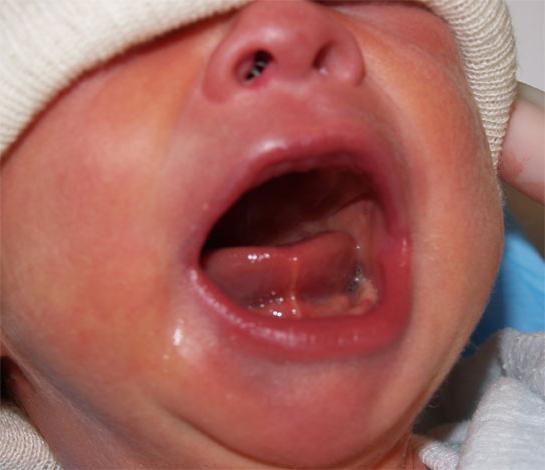
Among these infections:
- ARVI. A viral disease can be recognized by the accompanying symptoms: runny nose and cough.
- Laryngitis and pharyngitis most often occur as a complication after ARVI.
- Measles, rubella, and chickenpox are recognized by their characteristic rash. In this case, the help of a doctor is required immediately, since the newborn is in serious danger. Such diseases are more easily tolerated between the ages of approximately 3 and 7 years, but not up to a year.
- Sore throat is one of the most complex diseases, since the causative agent can be bacteria, fungus, or herpes. It is important to promptly recognize the source of infection in order to select the optimal treatment.
- Scarlet fever causes an excessively high temperature, a rash appears, and intoxication begins. In any case, such symptoms will force you to consult a doctor. As a rule, all children in the family fall ill with it, as is the case with measles, chickenpox, and rubella.
Recognizing a serious infection is usually not difficult, since the body temperature rises, the baby becomes lethargic, and a rash often appears if we are talking about specific infections. But when the symptoms are not so obvious, it can be difficult to understand what exactly is bothering the baby.
We create favorable conditions
- You need to know that in the case when the redness of the throat is accompanied by an elevated body temperature, then first of all, you need to give the baby an antipyretic, but you must take into account that in this way you will only temporarily reduce the temperature, although this is not always possible. To completely get rid of hyperthermia, it is necessary to calculate the cause and treat the disease that provokes the development of high temperature.
- You can start dripping from your nose. It is enough to use a regular saline solution purchased at a pharmacy or a chamomile decoction (but very weak). Drops will flow down the back wall of the nasopharynx, acting as antiseptics, which will reduce inflammation.
- If your toddler is breastfed, then under no circumstances should you stop feeding him this way. Most likely, the baby’s appetite will deteriorate significantly, and perhaps disappear altogether if it is very painful to swallow. But the mother should still continue to breastfeed her little one, but this needs to be done in small portions, but quite often. It turns out that human milk is a natural antiseptic.
- It is necessary to provide care for the baby, make sure that the little one drinks enough, especially if he sweats a lot, the need for fluid increases sharply. In case of high temperature, you should not wrap the child, otherwise it will grow even more. It is also important to give your baby plenty of water in case of severe intoxication of the body in order to quickly remove harmful substances.
- Great importance should be given to the temperature in the room where the little one is located. It should range from 20 to 22 degrees. And also to ensure that the air is clean, sufficiently humidified and fresh. That is why it is necessary to regularly carry out wet cleaning and ventilation.
